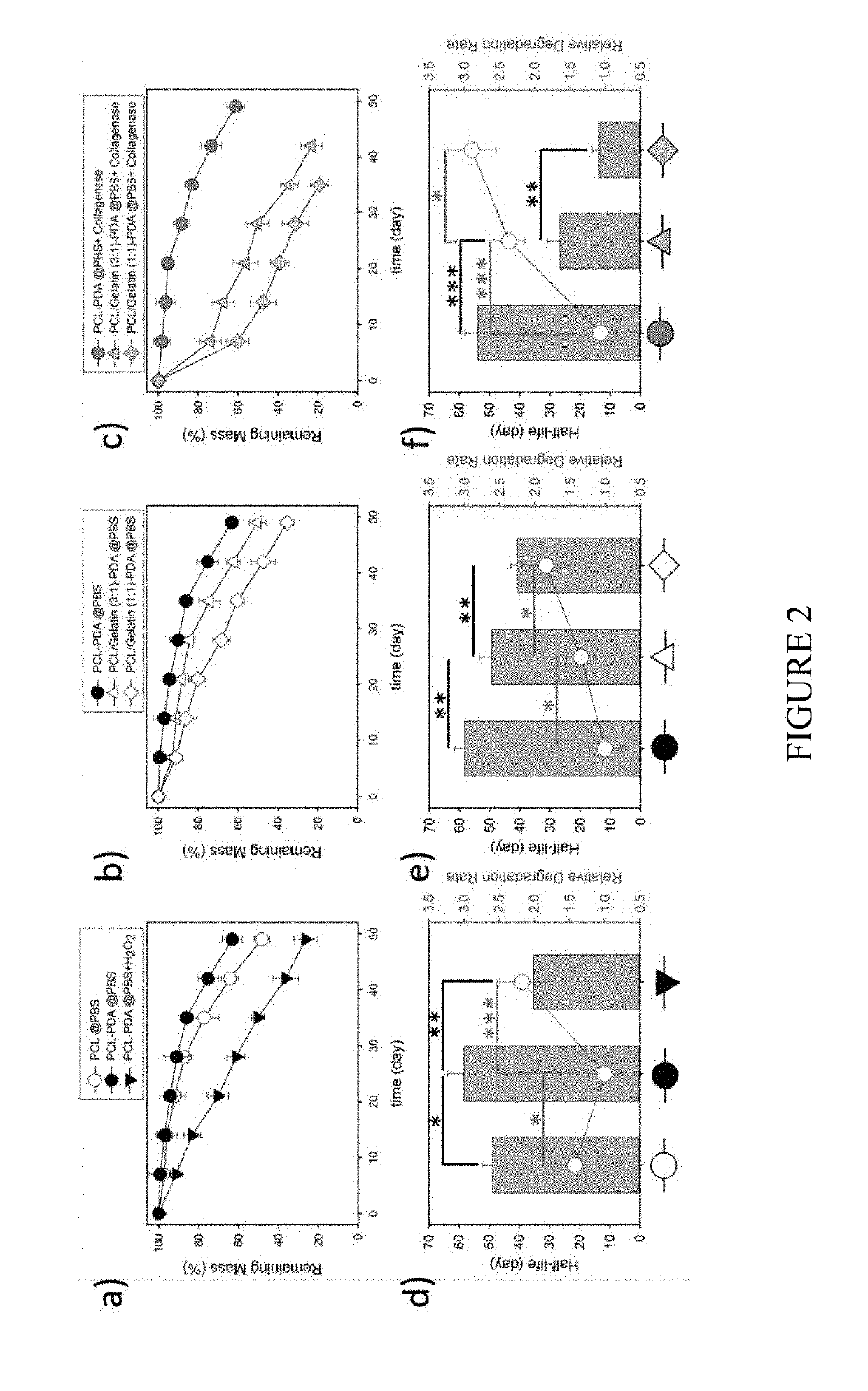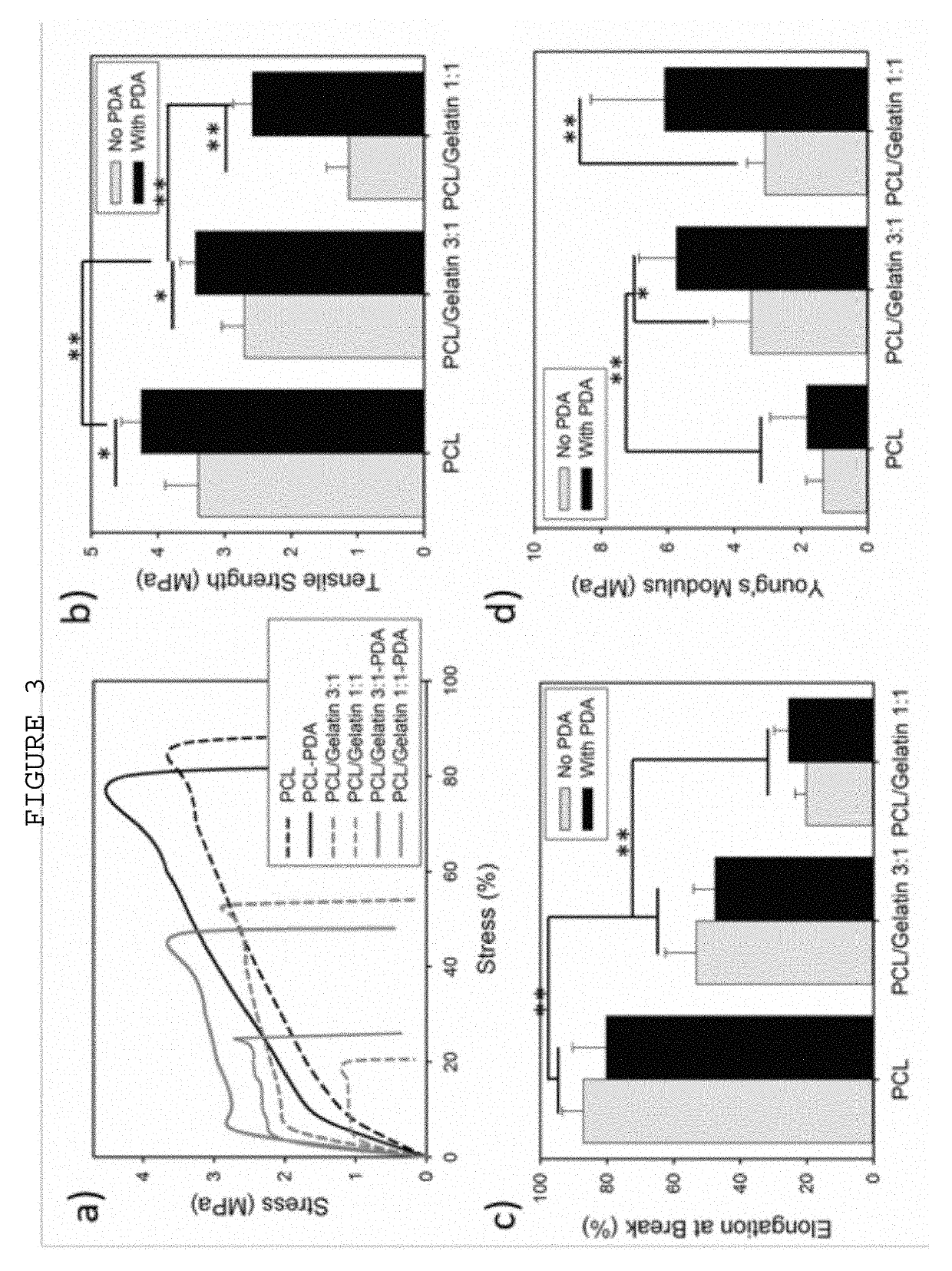Biomimetic membranes, methods of manufacture and uses thereof
a biomimetic membrane and composition technology, applied in the field of biomimetic membrane compositions, can solve the problems of inability to achieve ideal treatment for periodontitis, early tooth loss, and progressive loss of periodontal attachment, and achieve the effect of facilitating stem cell adhesion
- Summary
- Abstract
- Description
- Claims
- Application Information
AI Technical Summary
Benefits of technology
Problems solved by technology
Method used
Image
Examples
example 1
[0086]FIG. 1 illustrates fabrication of an exemplified membrane made of FDA-approved synthetic polymer poly (ε-caprolactone) (PCL) coated with polydopamine Testing demonstrated the PCL-PDA membrane exhibits and enables a surprising and unexpected combination of properties and / or functionalities, including tunable in vitro degradation (FIG. 2), tunable mechanical strength (FIG. 3), binding capacity with several cytokines / growth factors including stromal cell-derived factor 1 (SDF-1α) cytokine, recombinant human bone morphogenetic proteins-2 (rhBMP-2) growth factor, and Vascular endothelial growth factor (VEGF) (FIG. 4), fluorescence (FIG. 5), ability to culture viable periodontal ligament stem cells (FIG. 6) in controlled patterns (FIGS. 7 and 9), micro and nano processability (FIG. 8), mineralization (FIG. 10), and osteodifferentiation (FIG. 11).
[0087]In an embodiment, an application for the membranes described herein is as a barrier to exclude epithelium from tooth root surfaces. M...
example 2
Process Steps for Fabricating a Composition in Accordance with Described Embodiments
[0088]Process Steps
[0089]FIG. 20 illustrates methods of making membrane compositions in accordance with embodiments described herein, by integrating micro and / or nanotechnology techniques, as well as using the novel membrane compositions for tissue regeneration.
[0090]Block 1200 represents depositing a membrane comprising a synthetic polymer. In one or more examples, a structure, matrix, or network of fibers is deposited on a substrate, wherein the fibers each comprise the synthetic polymer and together form a fibrous membrane. In one example, the synthetic polymer is poly(ε-caprolactone). Example deposition techniques include, but are not limited to, electrospinning, sol-gel techniques, and plasma spraying, and any other suitable technique for achieving the desired result.
[0091]Block 1202 represents micropatterning niches, wells, openings, or cavities in a surface of the membrane, using a mold or pho...
example 3
[0103]A series of nanofibrous membranes with tunable mechanical and degradation properties were developed for periodontal tissue regeneration. Dopamine based biomimetic surface coating was utilized to promote the adhesion of cells and therapeutic proteins. To demonstrate potential applications of these membranes for craniofacial bone tissue engineering, we show that these biocompatible membranes are multifunctional and can deliver patient-derived dental stem cell monolayers or cell aggregates. Dopamine polymerization can be altered to add pH-dependent fluorescent properties to the structure, which can be used to monitor local inflammation in a label-free manner. Molecular and morphological micropatterning of the membranes can also be utilized to control cellular localization. The presence of polydopamine can promote osteogenic differentiation of dental-derived stem cells by accelerating hydroxyapatite mineralization. Quantum mechanical and molecular dynamics simulations were perform...
PUM
| Property | Measurement | Unit |
|---|---|---|
| Adhesion strength | aaaaa | aaaaa |
| Ratio | aaaaa | aaaaa |
| Cell angle | aaaaa | aaaaa |
Abstract
Description
Claims
Application Information
 Login to View More
Login to View More - Generate Ideas
- Intellectual Property
- Life Sciences
- Materials
- Tech Scout
- Unparalleled Data Quality
- Higher Quality Content
- 60% Fewer Hallucinations
Browse by: Latest US Patents, China's latest patents, Technical Efficacy Thesaurus, Application Domain, Technology Topic, Popular Technical Reports.
© 2025 PatSnap. All rights reserved.Legal|Privacy policy|Modern Slavery Act Transparency Statement|Sitemap|About US| Contact US: help@patsnap.com



